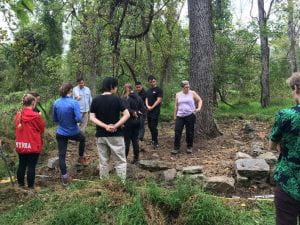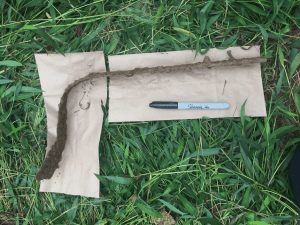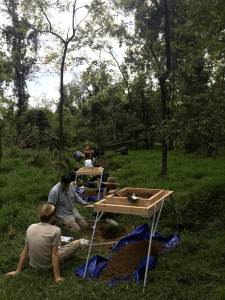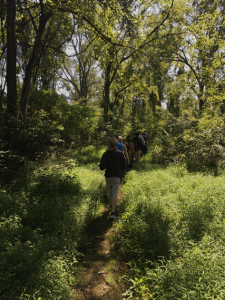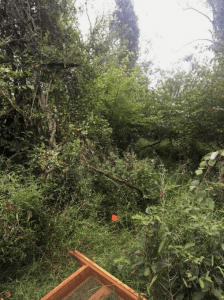People do not generally ‘hug’ each other as a way of greeting in the DRC. There are few air kisses on both cheeks, either. The proper way to greet someone, even if you know them well, is to shake their hand, or grip the top of the forearm. Typically, you smile and laugh as you do so, asking them, “habari, mama/papa/dada/kaka?” [how are you, mother/father/sister/brother]. Doing so shows attention to that person. It is respectful. In the past few weeks, I have conducted this ritual over and over again—complete with handshakes. I must have physically touched at least 70 different mamas, papas, dadas, and kakas.
Hand shaking was far away from my mind at 8pm on the 17th of July, as I was preparing to go to sleep. My immediate plan to stumble exhaustedly into bed was nonetheless foiled by knocking. In my doorway stood a friend who works at a UN agency. Usually this friend is somewhat, shall I say, cavalier about safety: they have a self-described reckless streak and work on DDR—disarmament, demobilization, reintegration—which means that they spend a lot of their time negotiating with rebel militias in the most remote parts of the country. Not exactly the most secure of jobs. So when this friend stood at my doorway that night, and told me, “I just came to see if you are still working with the [x] community. You need to stop shaking hands.” My stomach dropped. All desire for sleep was immediately excised from my mind. My friend did not need to say it explicitly. Ebola. Apparently, one of the most recently diagnosed ‘cases’—that is, the person diagnosed with the virus—had been from Bukavu, and had worked in the community I worked in. I thought, immediately, to all of the many hands and arms I had touched in greeting and comradery, the physical touch that had connected me to others was kaleidoscopically rearranged as hazardous, dangerous, tainted. “Just wait,” my friend continued, “This is going to blow up, big time.” Less than half an hour later, the World Health Organization [WHO] announced that the Ebola epidemic in the DRC, which has been going on for almost a year with little attention from the West, warrants a “public health emergency of international concern.” To put this into context, there have only been four public health emergencies declarations from the WHO since 2005—the decision to declare an emergency in these kinds of situations is not made lightly. Moments later, the texts and emails from concerned family members and friends—who I am so thoroughly lucky to have caring about me—began flooding in. I also began reaching out to people, to colleagues, feeling scared and alone, trapped in a catastrophizing mind of worst-case-scenarios. Thoughts of sleeping were pushed aside.
Despite the emergency declaration and my sleepless night, the sun rose on Bukavu the next morning as it always does. The people of the city began their day, seemingly untouched by the impending peril. The only change to the rhythm of everyday life, at least for me, was the new requirement of a mandatory chlorine handwash at the entry points of the building I worked in. Haunted by the gentle (and sometime less gentle) urgings of many of my loving family and friends that it is, perhaps, in my best interest to leave the country since there has been a declaration of a public health emergency in the DRC, the contrast between the banality of the unfolding day in the DRC and the sensational panic of the emergency declaration that was circulating in the fears of my relations—and the West, more generally—felt paralyzing. This feeling of being at once detached from the problem and my ability to escape it if I so chose: I realized that this was perhaps the most pronounced embodiment of privilege I have ever consciously occupied. And that, I am sad to say, was paralyzing, too.
Let me be transparent. The Ebola epidemic in the DRC is deadly serious, and although health workers—local and foreign—have clearly done excellent work in attempting to contain it (in particular, through the tracing of contacts and ring vaccinations), the rising number of cases and isolated cases that have been diagnosed in large cities or border regions are extremely concerning. As the new emergency declaration suggests, there is a high likelihood that the outbreak will spread, not only to the region in the DRC where I am living, but to other countries. The effort to quell the epidemic does require external support, namely funding, in order to succeed. If an emergency declaration is necessary to gain attention and press for support, then so be it. The volatility of the epidemic is such that I may indeed use my privilege to leave the DRC earlier than planned, especially depending on the likelihood of borders remaining open. In staying, even if only for now, I am also fielding accusations that I am somewhat stupid by otherwise well-meaning relations abroad. And while that may be true, the reality is that I take a minuscule risk compared to other people in the DRC who are more likely to contract the virus due to proximity, and they, due to the many constraints of structural violence, do not have a choice but to pray that it does not spread. And that, it seems, is how people here manage to get on with their days, and not succumb to panic. I spoke to many people today who told me that yes, they are scared, but they are only praying that the virus does not come to Bukavu.
Meanwhile, the daily life of the city continues largely unchanged, and I wrestle with questions of belief, rationality, and rumours.
A friend, collaborator, and local Bukavu man, somewhat derisively laughed off the fears of my relations, and the panic being provoked in Western media. “It is one case in Goma,” he said, “If there were 10 cases there, the West would declare it a weapon of war,” implying that the significance of the emergency declaration is overblown and, perhaps, serves an international rather than local agenda. It is clear that he finds the fears surrounding Ebola from the Western perspective, at least as they played out in the prior 24 hours, to be somewhat sensationalist. And given the routineness of everyday life around us, it is not hard to see why he is dismissive.
But later, after walking around a local neighbourhood and talking with people who live there, we come across the story of kabanga. The kabanga is a type of occult murder practice that involves a person using a garrote to strange a victim, and the garrote cord is then sold as a kind of talisman that can be used for witchcraft. Interestingly, the market for the garrote is muzungus—white people. There are many recorded murders that have been based on this practice. My friend asks me why muzungus would want such an occult item, and whether it is common for us to believe in such things. I answer something along the lines of, “no, it’s not very rational to us,” and say that I can’t explain why someone like me would want to purchase such an item, which apparently fetches quite a lot of money. “It sounds like a bit of a rumour,” I say: not dismissing that such garrote murders do happen, but perhaps being dismissive of the idea that white people buy the cords from such murders. “But,” my collaborator went on, “you and your friends abroad believe rumours about the spread of a virus to here, even if it is only one case?” And it is, in a way, true—my initial fear had been literally whispered to me as a rumour at 8pm at night by a concerned friend passing on a message based on information I myself don’t have access to. I had believed that person, and easily absorbed the panic about ‘my situation’—that being that simply standing in the DRC right now exposes me to a deadly virus. Why? Because I was basing my evaluation on the perceived rationality of a figure from a source—the UN—that I considered to be inherently authoritative? Or because the phenomenon at hand is a medically documented virus, with scientific evidence of epidemic levels of infection? Or, more frighteningly, because of narratives about Africa being inherently dangerous that are all too easy to resort to in the face of an actual hazard?
Through this conversation, both my friend and I were curiously questioning the rationality of the other’s belief systems, both of us invested in the rumours that brought us to our eventual judgement on the situation at hand. Neither of us may grasp the reality of the situations we are discussing, but what is clear is that such phenomenon—whether the spread of a virus or witchcraft—are not wholly reducible to logic and rationality.
Perhaps it this perceived unpredictability and very volatility of such situations from which we derive our fears. Unfortunately, those fears are nonetheless rooted in realities of violence and the possibility of death.








